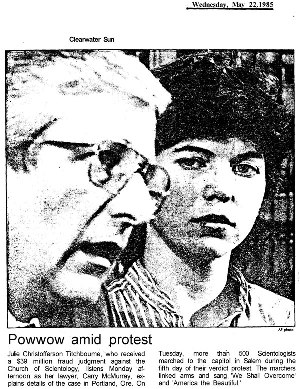Julie Christofferson Titchbourne
Former scientologist, sued the Church and Hubbard for $43 million.
This led her to claim damages against the Church of Scientology because it had made fraudulent claims that it would improve her eyesight and raise her intelligence. The case seemed to set a precedent in that claims made by religious organizations could be considered subject to laws governing consumer goods. At first the lawsuit asked for $30,000 but this soon grew and Julie was awarded $2 million in damages in 1979. The Church of Scientology successfully appealed, and a re-trial was ordered. In 1983 Mrs Titchbourne made her eighth change in the damages sought; she asked for $43 million. The trial proceeded with attorney Garry McMurry representing her, and Earle Cooley for the Church of Scientology of California. Julie had added a request for damages against Hubbard himself to her suit. The testimony was of a general nature relating to Hubbard, the RPF, the culling of pc folders and other examples of Church of Scientology misconduct.
On Friday, 17 May 1985 the jury announced its verdict: $39 million damages, of which $20 million were awarded against Hubbard personally. This led to thousands of Scientologists assembling in Oregon to protest the decision. John Travolta flew into Oregon in his Lear jet to join in the protest, and Chick Corea cancelled a concert to attend. Judge Londer granted a mistrial on the grounds that McMurry's closing speech was improper and prejudicial for mentioning the RPF and culling of folders for assessment of damages, and that his remarks that the jury could determine which Scientology courses were secular and which were religious amounted to a directed verdict. — Lamont. (Also, Julie Christofferson Titchbourne.)»
[Source: "Who's Who in Scientology" by Martin Hunt]
 Dan Garvin: Be Glad
You Lost, Julie
Dan Garvin: Be Glad
You Lost, Julie
The New York Times (May 1985): "Church of Scientology Loses $39 Million in Fraud Lawsuit"
The Multnomah Circuit Court jury, after a 10-week trial and two and a half days of deliberations, found that the church defrauded the woman, Julie Christofferson Titchbourne, who had been a church member for nine months.
Willamette Week (May 1985): "Scientology on trial"
- Deceit so rampant that it permeates the organization;
- Shocking and effective methods of controlling its members, especially full time staff members;
- A much-used and almost limitless policy of attacking anyone who dares to criticize or attempts to expose aspects of the group (this policy is used not only against people who actually commit some action against Scientology, but also against many, both in and out of the group, who might do so);
- A lust for money that has resulted in staggering volumes of income for the group;
- An organizational structure designed to maximize the power and income of L. Ron Hubbard, while concealing both.
The Reader's Digest (May 1980?): "Scientology: Anatomy of a Frightening Cult" by Eugene H. Methvin
As Margaret Thaler Singer, a University of California psychologist who interviewed Julie and over 400 former members of cults, observes, “These routines can split the personality into a severe, dissociated state, and the recruits are hooked before they realize what is happening.”
Julie found that the next step, auditing, continued to erase the boundary between reality and fantasy. In this phase, Julie exhausted all $3000 of her college savings. Then she was told she could take college-level courses while going “on staff” and working full-time to recruit and process new raw meat. She ended up working 60 to 80 hours a week, at a maximum salary of $7.50. She had now reached the “robotlike” state.
Julie felt superior, one of the chosen elite of the universe. She was one of the faithful who are promised they will “go with Ron to the next planet.” Thus, they are conditioned to the “us against them” outlook that characterizes so much religious and political fanaticism.
Julie Christofferson was among the lucky, however. After nine months, her parents removed her from the cult and snapped her out of her zombielike trance. Last August, a Portland, Ore., jury found the church's conduct so fraudulent and outrageous that it awarded her $2,067,000.20 in damages.
The Oregonian (Jul. 1979): "Witness describes Scientology drills" by John Painter Jr.
One particular "drill" called "bull baiting" involved verbal and physical abuse and sometimes overt sexual contact, Diana Morgan testified.
She appeared as a witness for Julie Christofferson Titchbourne, 21, in the trial of a $2 million-plus damage suit Mrs. Titchbourne brought against three Scientology organizations and adherents.
She is seeking damages on allegations of misrepresentations, common law fraud and outrageous conduct. [...]